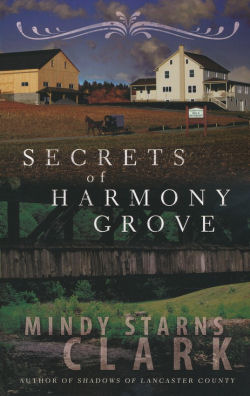|
There
are sub-genres and then there are sub-sub-genres, but how I managed to
find myself writing in a sub-sub-sub-genre is no mystery to me. All I
have to do is walk into a library and inhale that old-book smell—the
intoxicating scent of stories waiting to be discovered, characters to
befriend, pages to be turned—and my mind goes straight to my first
literary love: Gothics. Given my lifelong fascination with this
spine-tingling genre, it’s not surprising that eventually I would
dabble in it myself. But because I’m a Christian author who enjoys
writing about the Amish, I decided to find a way to combine all of the
above, making me, to my knowledge, the only Christian Amish Gothic
mystery writer out there.
So what is a Gothic? Though
Horace Walpole laid the groundwork in 1764 with The Castle of
Otranto, Gothics as a genre would evolve and change over the
next two hundred years. By the 1950s, they were defined by:
Setting: ancient
castles or big, creepy old houses, often with hidden staircases, secret
passageways, etc., and usually somewhere remote and exotic
Protagonist: a young,
attractive woman who has been in some way left utterly alone (via death
of her parents, abandoned by husband, etc.)
Antagonist: often a
powerful, manipulative older relative
POV: first person
through the eyes of the young heroine
Atmosphere: often
gloomy: fog, darkness, rain, etc.
Tone: impending
danger, mystery, and near-excruciating suspense
Foreshadowing & Plot:
an old family warning or prediction, odd happenings, unsettling
characters, and vague threats
The first Gothic I read was Mary
Stewart’s Touch Not the Cat. I can still remember
the chill bumps, the shivers, the gut-wrenching fear as the heroine
wandered labyrinthine hallways, hidden staircases, and fog-shrouded
gardens. If every mystery is in part about the exciting anticipation
of what’s to come, a Gothic is that anticipation times ten. The masters
of the genre—Phyllis A. Whitney, Mary Stewart, Victoria Holt, et
al.—did this with tremendous finesse. When I was younger,
opening the cover of one of their books felt much like waiting in line
for a roller coaster ride. Terrifying. Dreadful. Unbearably exciting.
Of course, after devouring the story in a single sitting, I would
usually lie awake all night, eyes wide, as every creak of the house
grew predatory and sinister. Ah, the delicious terror of it all.
Over the years, I discovered
many other favorite mystery sub-genres, first as a reader then as a
writer. My literary debut took the form of a private investigator
series, (the Million Dollar Mysteries), then I moved on to humorous
cozies (the Smart Chick Mysteries.) After that, I decided that I wanted
to revisit my first love and try some good, old-fashioned Gothics.
Though I wanted my stories to include many of the elements of the genre
listed above, there were other characteristics that would need
tweaking, such as:
Shifting the
backstory
Almost every Phyllis A. Whitney
novel begins with the young heroine on her way to an old family home,
having been summoned by a letter or similar. As she rides the train
(boat, plane, etc.), she thinks at length about all things that led up
to this moment of her life. Of course, today’s readers wouldn’t slog
through two paragraphs of that, much less several pages, so my stories
would need a more modern construction with backstory lightly sprinkled
throughout a more action-packed tale.
This was easier said than done
given that Gothics can require some very complicated backstory. With my
first Gothic, Whispers of the Bayou, I included the
requisite letter that would summon my heroine, Miranda, but I preceded
that with an encounter with a mysterious stranger, a bizarre attack in
an alley by two thugs, and the revelation of a shocking secret by
Miranda’s aunt. By the time our heroine boards a plane and heads for
the old family home, set along a Louisiana bayou, we’re ready to learn
a little more about her.
Expanding the
setting
Though I loved the
claustrophobic feel of Gothics, I had trouble leaving my heroine
completely stranded. Ours is a far more mobile and connected society
than those portrayed in the older Gothics, which means that regardless
of location nowadays she would almost certainly have a car, cell,
laptop, etc., at her disposal. Trying to get around that required
serious and credibility-straining machinations.
Thus, I surrendered my desire to
keep her totally isolated and allow her some mobility and
communications to take place. I set
|
my
second Gothic, Shadows
of Lancaster County, in the dead of winter and used bad
weather and icy roads to keep her trapped as much as possible. I also
put her in a Amish home, where the lack of electricity would make it
hard to recharge her cell and laptop. Still, in the end, my heroines
have all covered far more territory in the course of the story than
their Gothic counterparts of yore, who rarely wandered past the
backyard.
Eliminating
the HWTSTL
My biggest pet peeve in any
mystery is what’s known as an HWTSTL, or Heroine Who’s Too Stupid to
Live; for example, one who tiptoes out the backdoor in her nightgown,
bearing only a candle, to check out the creepy noise coming from the
yard. Puh-leeze! To keep my heroines brave but not stupid, I picture
myself in the same situation and then go with the action that I would
take if I were there. (Trust me, if there’s a scary noise out back and
I’m home alone in my nightgown with just a candle, I’m running around
locking every window and door even as I’m hitting 9-1-1 on speed dial
and reaching for the fire poker! Ergo, that’s what my characters are
most likely to do as well.)
My third Gothic, Under
the Cajun Moon, features an exciting cat-and-mouse chase
through the Louisiana backwaters, much of it at night. For research, my
husband and I forced ourselves to stay in a swamp cabin, go outside at
3 a.m., and take note of how it felt, smelled, looked, and sounded. Let
me just say that standing on the dock beside that black water without a
soul around nor even a flashlight was one of the most terrifying
experiences of our lives. The research payoff was tremendous—my
character’s time in the swamp feels very real (not to mention
horrifying) indeed—but between the plops, gurgles, and glowing eyes
that surrounded us on every side, we were having our own TSTL moment
just by being there!
Justifying the
essential elements
Why would I want to write a
Gothic if it didn’t include hidden staircases, secret passageways, and
even buried treasures? I wouldn’t! The problem is that in this day and
age, each of these has become what you might call laughably cliché.
What’s a writer of a modern
Gothic to do?
Because the thrill of the genre
is intrinsically woven into elements such as these, I decided that they
would stand. To combat the cliché factor, I make them necessary for the
setting, plausible for the characters, and utterly intrinsic to the
plot.
In my fourth and most recent
Gothic, Secrets of Harmony Grove, the buried
treasure in question is a cache of diamonds linked to WWII Europe and
the heroine’s Amish grandfather, who served as a noncombatant army
medic and was present at the liberation of Buchenwald. In the end, the
diamonds are not a mere Gothic “device” but a poignant symbol of the
Holocaust, life’s fragility, and the enduring hope of the human spirit.
With its heady themes, isolated location, and eerie tone, this book is
my most Gothic-feeling yet.
Even as I move on to explore
other genres and sub-genres with my writing, I’ll revisit the Gothic
with future books. “Christian Amish Gothic Mystery” may sound like an
oxymoron, but in truth it’s more like that literary equivalent of a
roller coaster ride.
Time for some delicious terror,
anyone?


|









